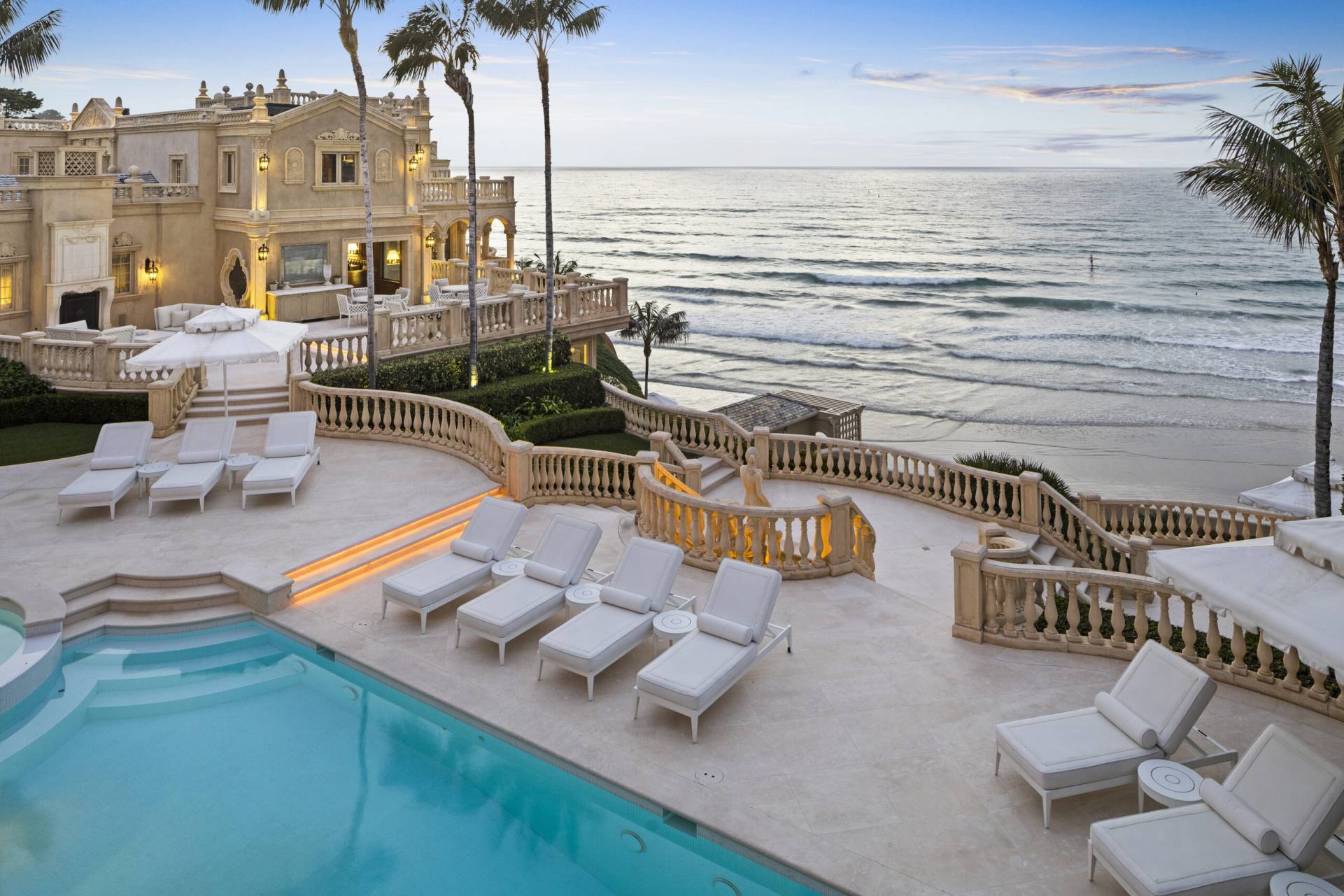Early reports of the death of the townhome appear to have been greatly exaggerated.
A private garage for two cars; flex space ideal for teens, guests or an office; a light-filled interior with generous rooms between multiple levels. Decks, porches and patios, open interiors to the outside. The feeling is expansive and private. Welcome to the new townhome.
“Back down. The townhome is dead” was cautionary advice Jeff Benach, principal of Chicago-based Lexington Homes, often heard during the recession. But that wasn’t the experience for his firm, which, he says, always had been “pretty strong on townhomes.” They continued to offer this option. “A couple of years later in 2011 and 2012, all of a sudden the townhome is becoming the it property type,” he says. Few other types of residential housing have had a resurgence of interest as town-homes, and few others have undergone as many fundamental changes in architecture, floor plans and finishes. Elevated design and dynamic architecture are only part of this newfound appeal. Cost, location, and lifestyle — which often is more important than price for buyers — also come into play.
Long perceived as second best, town-houses are no longer viewed as merely a less costly alternative to single-family homes. Instead, the appeal extends to a surprising span of life stages and lifestyles from entry-level to move-up to affluent.
No Longer Second Best
“We’re starting to see, and I’ve seen more of lately, something I never saw in my 30-plus years of doing this, and that is families, young families with kids looking for a townhouse for school districts or other reasons,” explains Benach. “This obviously signals a shift in who is buying townhomes, whereas before it was first-time or move-down buyers.” Also, school districts have become a much bigger factor for potential buyers, which, Benach says, reflects a much greater acceptance of townhomes as a longer term, grow-to product.
“Luxury townhouses in New York City are increasingly offering homeowners more options and choices when it comes to their lifestyle. A townhouse generally provides homeowners more living space and the opportunity to have a residential experience that is closer to a single-home lifestyle, which is hard to find in a metropolitan area. The townhouse can offer a family room to grow and more flexibility as needs change in the future,” explains David Dynega, CEO of Detail Renovations in Great Neck, N.Y.
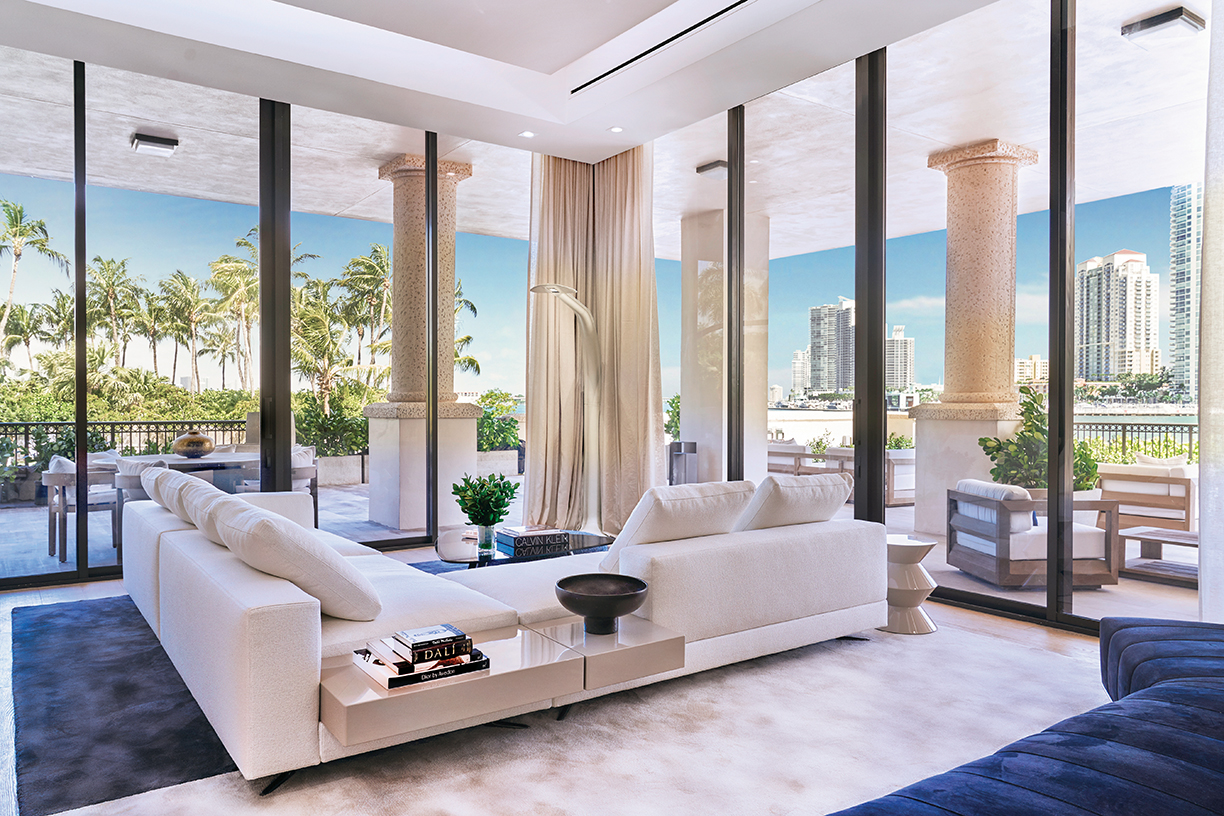
PHOTO COURTESY KOBI KARP ARCHITECTURE AND INTERIOR DESIGN
Walls of glass bring the tropical landscape into the experience of this townhome on Fisher Island.
The ability to lock and leave without compromising on outdoor connections and privacy is another incentive. “Living in a townhouse-style building, I literally lock my door and leave. I’m walkable to downtown and I have no anxiety about maintaining or the lawn or yard or snow removal. It’s taken care of. I think that’s the benefit for a more transient society, especially people with multiple dwellings,” shares Michigan architect Wayne Visbeen, principal and founder of Visbeen Architects.
“The keyword in townhome is home,” observes Kobi Karp, principal of Kobi Karp Architecture & Interior Design. “It’s a very habitable home, a house within the town. That’s really the way we see it, and it’s traditionally, historically been as such,” he says reflecting on the tradition of grand urban residences from the era of the Vanderbilt and J.P. Morgan. “A lot of our projects are infilled in urban spaces, and people are using town-houses to be unique destinations for their family within the urban center,” he explains.
“The townhouses you see now are designed much more like a single-family home, and people want a single-family feel even to an attached home,” says Michael Stone, senior designer at Bassenian Lagoni Architects in Newport Beach, California. While attached multi-story dwellings, traditionally called row homes, are what many still envision at the mention of townhouses, this option today has a range of iterations. “It seems like each week we are seeing a new spin on the attached product,” shares Stone.
Today, townhouses can be clustered on small lots. Some are freestanding, like some historical homes in New York City, or they might be attached. They can also be part of a highrise building. “We create them on lanai decks; we create them on rooftops,” says Karp. Location is key and an address in a highly desirable, prestigious neighborhood in cities including New York or Miami adds to the appeal and the cachet of the property. Being part of a high rise also usu-ally enables townhome owners to enjoy all of the amenities of the building.
Even new master-planned communities — usually with diverse property types, prices and sizes — often include town-houses in walkable locations close to the hub of activity.
Getting More With Less
Kobi Karp lives in a townhouse. Wayne Visbeen lives in what might be considered a new vision for townhouses. His is a three-story live-work space. “I think the thing that is similar between townhouses and single-family homes is we’re all trying to figure out ways of getting more for less. So how do you use space efficiently, no matter how luxurious? It is something that even my very-high-end clients are looking for,” he says. His own home is only 20-feet wide; yet, he says, people are shocked when they learn how narrow the home is. What makes the difference? Ceiling heights give volume and expansive windows bring in light.
Visbeen, who has won design and architectural awards for both custom and production homes, tends to think about space innovatively. A good example is a large room in his home designed to be adapted to multiple uses, including a rec room, a guest suite and a conference room for his business. This type of space is something Visbeen says he is incorporating into almost all new designs from townhouses to single-family residences.
What makes a townhouse today differ-ent from one designed decades ago? Light, maximizing square footage, floor plans oriented for privacy and indoor/outdoor connections. Even entries have been reorganized with direct access to a residence from a private garage, which is more often than not, spacious enough for two cars and additional storage.
It’s All About The Light
Interiors infused with light dispel any sense of compromise regarding square foot-age or the size of a lot, even for attached homes. For example, in a recent plan created by Bassenian Lagoni, individual town homes were attached along the rear wall. The entries faced opposite streets and the orientation allowed for the placement of windows, large banks of windows, on three sides.
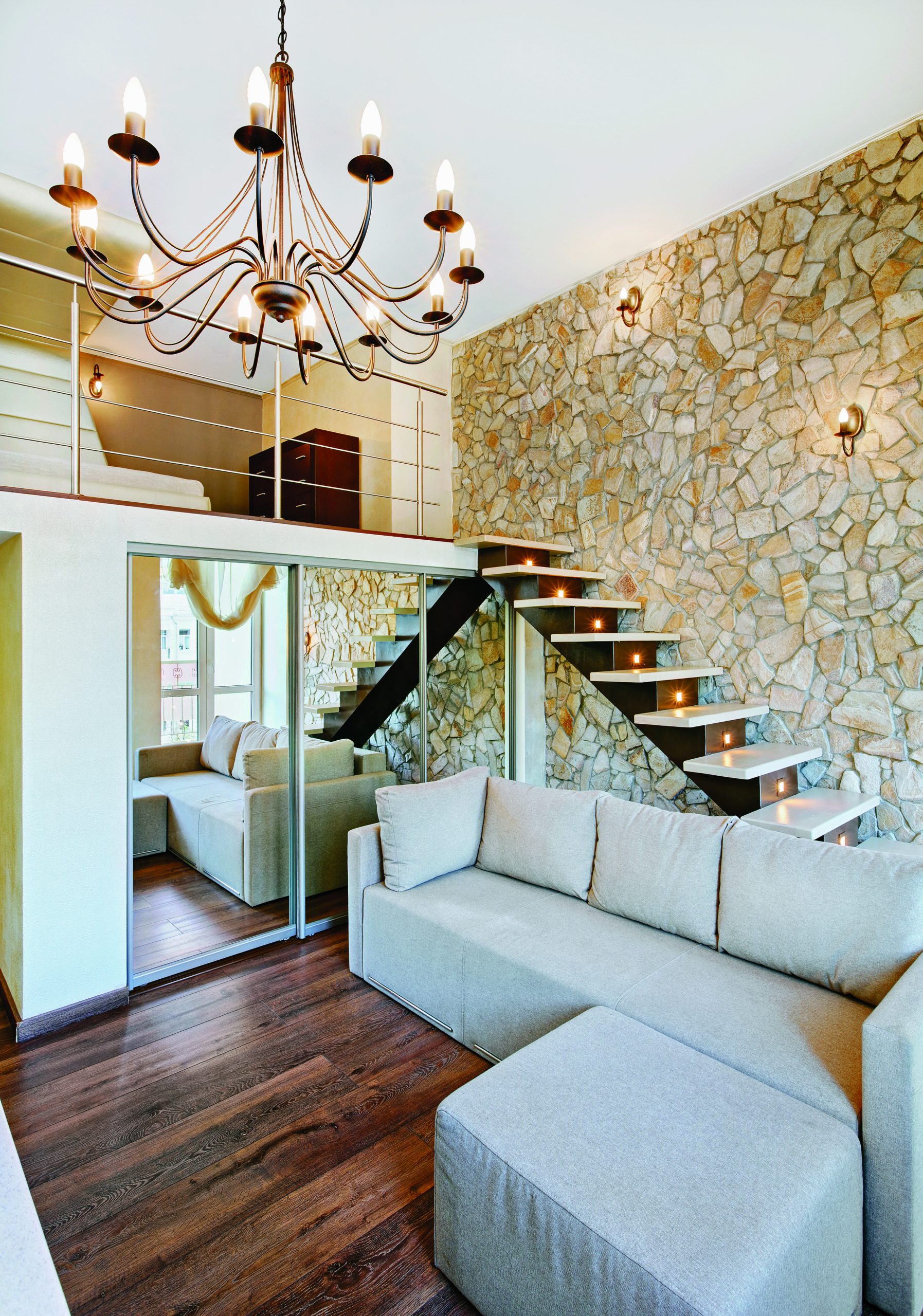
©ISTOCKPHOTO.COM / PHOTO_HAMSTERMAN
Strategic positioning of stairs connect levels and enhance light in new townhome designs.
Often, stairways are open and positioned to transmit light through two or more levels of the home and to also visually connect multiple levels without sacrificing valuable interior space. For upscale properties, elevators are becoming a non-negotiable item, particularly in new construction on sites where the enhanced value derived by the location and the land often more than exceeds the cost of an elevator.
A new spin on townhomes from Lexington Homes, is something Benach describes as a bit of a hybrid. “It’s a town-home in that the main footprint where people live is about a 40- by 22- or 21-foot footprint, times three stories.” In a typical old-style townhome, the garage would be in front or in the rear but still integral to the building. But in Benach’s hybrid model, the entire house is “all living space.” The back door opens to a rear yard and a garage that fronts on an alley. “So, it’s just like a city single family home, except they are attached. And there is a weathered-board fence between each one, so you’ve got your own little private back yard,” along with a garage, he says.
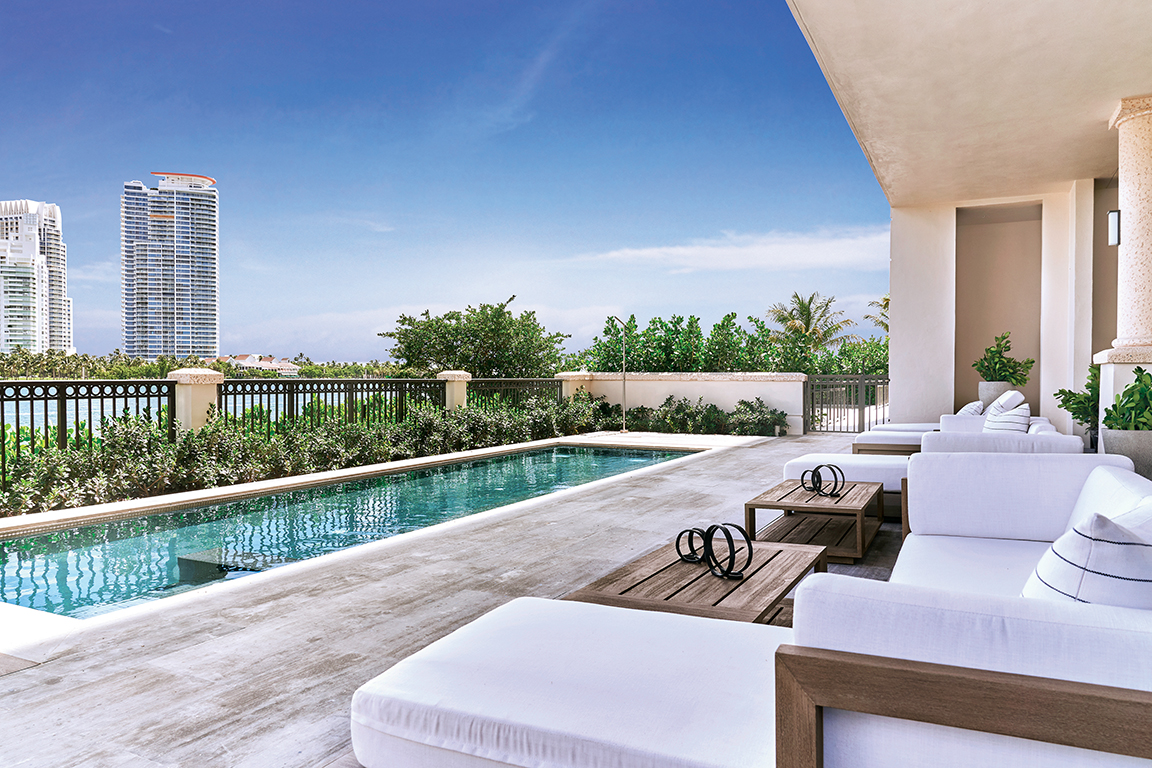
PHOTO COURTESY KOBI KARP ARCHITECTURE AND INTERIOR DESIGN
Whether a covered deck, garden, pool or simply a small patio, outdoor spaces are some of the most desired amenities in townhomes.
Outdoor Attachments
A small outdoor space, especially in urban centers, is one of the most desired amenities offered by townhomes. It’s something many do not want to sacrifice just because they live in a metropolitan area.
Equally fundamental to an experience akin to single-family are decks, patios and porches, often on multiple levels of the home. Not only do they provide an essential connection to nature, but they extend the square footage, often via stacking or telescoping doors that completely
merge inside and out. Often, for homes located above parking garages or in high-rise buildings, they create opportunities for outdoor living — even small gardens or play areas in locations and sites where such access is almost impossible. Being able to walk outside or dine, possibly in a covered outdoor room, brings an entirely new dimension to the townhome experience. The latest “must-have” outdoor amenity is a rooftop deck, which in many locations maximizes views. Outdoor kitchens and dinning, gardens, pools, and play areas make this amenity space even more desirable.
Outdoor Living Inside The Home
Another strategy architects employ to create outdoor connections and infuse natural light into the center of townhouses is interior courtyards, often sited next to a side yard or the rear, with the home grouped around it in a U-shape. In addition to opening ground-level spaces (often via disappearing doors) to the outdoors, they create opportunities for additional windows and even large expanses of glass on upper levels. In all price ranges, the use of transom glass at the top of walls or over windows and doors further opens interiors on upper levels.
Private courtyards within the townhouse also evoke historical ties to turn-of-the-century townhomes in New York. “Those homes were highly glazed with interaction and connectivity to the landscaping, and to the gardens,” says Karp.
In addition to outdoor living options, having square footage distributed between multiple levels is a main differentiator between a flat and a townhouse.
The interaction between indoors and outdoors also differentiates a townhouse from a flat as does having living spaces on multiple levels. Both create value and enhance privacy and the essential sense of home. “It gives you a little bit of separation. It’s physical and mental privacy,” says Karp.
“Additionally, particularly for high-end homes, taller rooms often found in town-homes are ideal to display art,” observes Karp, a feature increasing desired by affluent owners.
Even for the affluent, especially in urban centers, Karp says, “a big house and land isn’t necessarily as financially feasible as it is to maintain a luxury townhome in a town center where you live it and you use it in a more efficient manner. You live and you use every room of the townhouse, where I give you a sprawling house in the city and there’s rooms you never walk into.”
This editorial originally appeared in The High End Winter 2020.
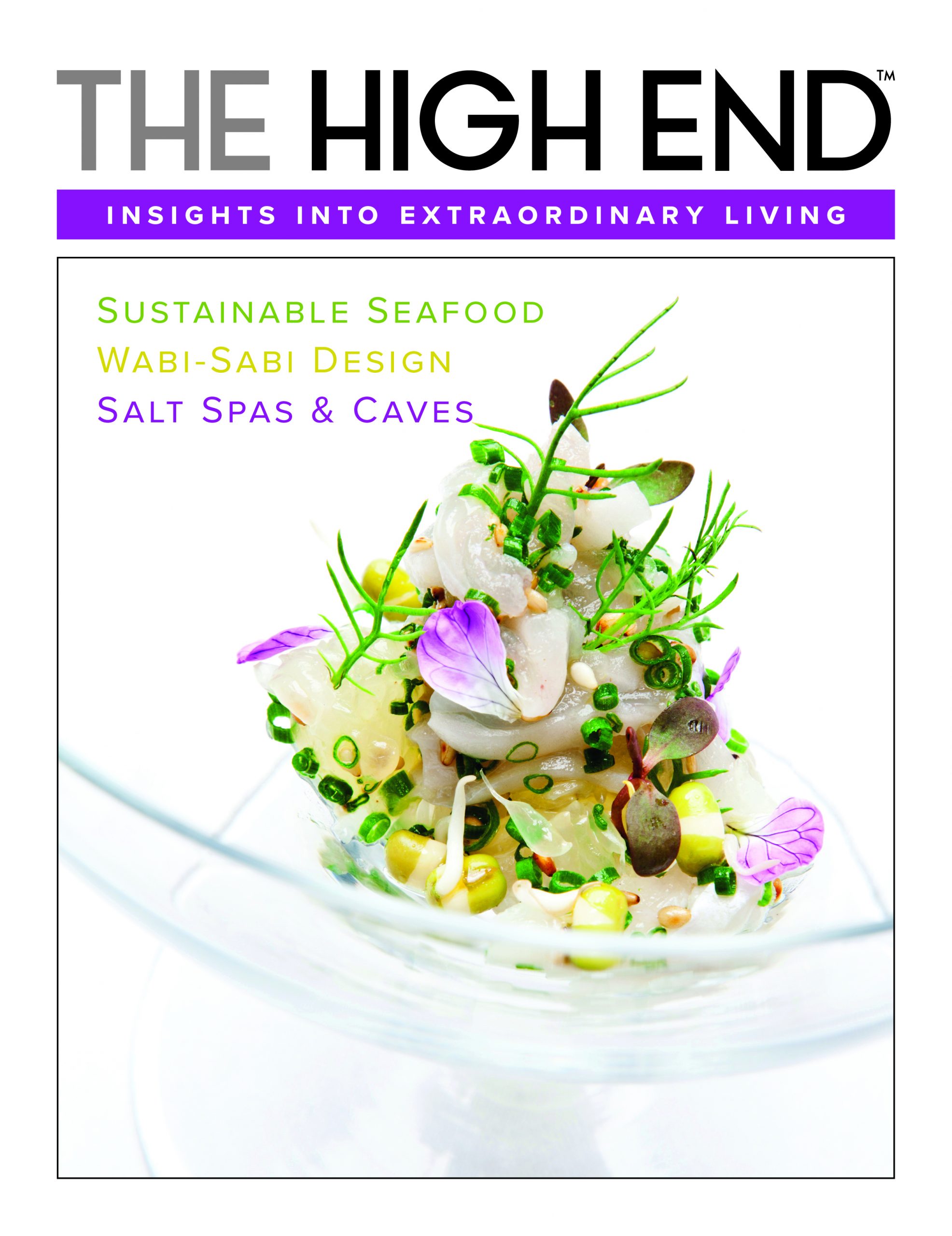
Exploring the world on two wheels offers an experience like no other, providing an addictive free-wheeling freedom that you just can’t get from the confines of a typical automobile. These high-end motorcycle models set in motion the future of contemporary riding. Designed by some of the most iconic American motorcycle manufacturers, and European competitors, these bikes promise a variety of devil-may-care cruising — from smooth, solitary highway grand touring to gutsy track-inspired journeying across unpredictable curves and stretches. There’s nothing like the open road.
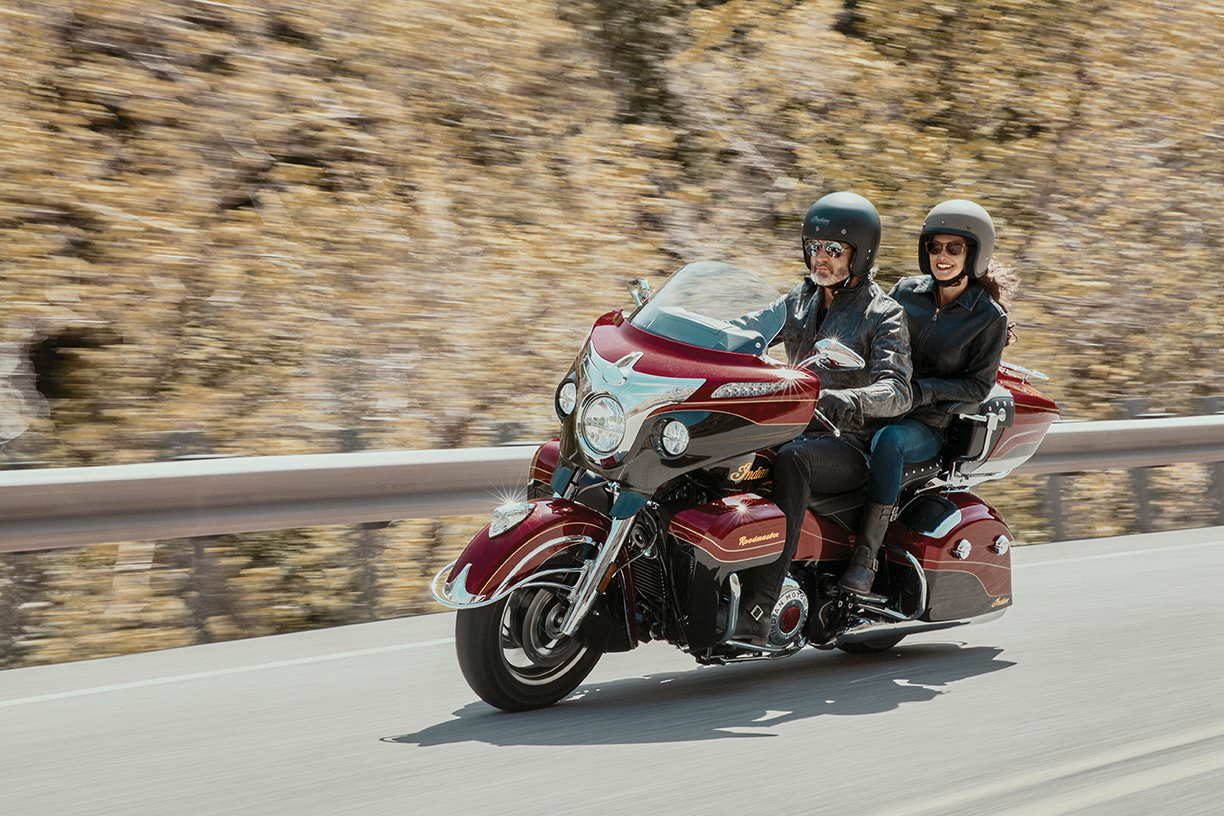
Indian Roadmaster Elite. Photo courtesy of Indian Motorcycle.

Photo courtesy of Indian Motorcycle.
Indian Roadmaster Elite
Starting at $36,999
The Roadmaster Elite from iconic American motorcycle manufacturer, Indian, is packed with the comfort and force needed for the open road, making it the ultimate master roadster. The luxurious machine features two-tone paint in “Red Candy” over “Thunder Black Crystal” that takes a whopping 30 hours to complete and fi nish by hand; and the logo badging is embossed in 24-karat gold leaf trim, sure to catch the sunlight in the passing lane.
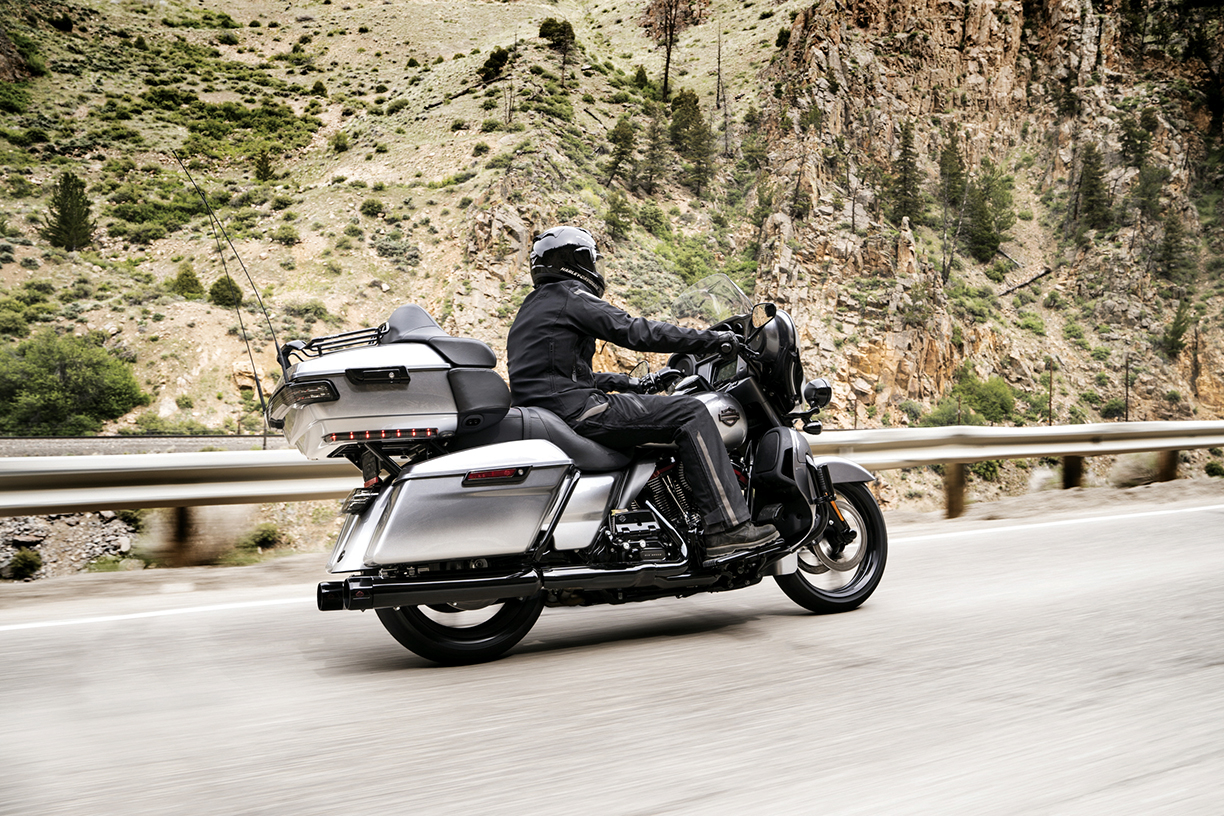
Photo courtesy of Andy Mahr, Harley-Davidson Motor Co.
Harley-Davidson CVO Limited
Starting at $43,889
An enduring symbol of Americana, Harley-Davidson ensures time-honored performance and design that lives in the realm of cultural icon. The 2019 CVO Limited offers loyal Harley-Davidson riders the grandest experience of American touring by fusing contemporary elements with classic design. Technology-forward integrations allow for a plugged-in cruise atop the most powerful V-Twin engine ever offered from the company — the Milwaukee-Eight Twin-Cooled 117 Engine, which is only available in CVO models.

Photo courtesy of Triumph Motorcylces LTD.
Triumph, Rocket III Roadster
Starting from $15,775
The signature twin-headlights look of British motorcycle manufacturer Triumph’s Rocket III Roadster has just as much impact as its powerhouse engine. This premium flagship bike’s blacked-out silhouette, chrome headers and detailing confirm that looks, can in fact, kill. If you live to start the engine, hold a solid grip because the world’s largest production engine has more torque than ever. Fit with a three-header exhaust that growls deep to make your presence known on the road, this cruiser is all about free and easy riding.
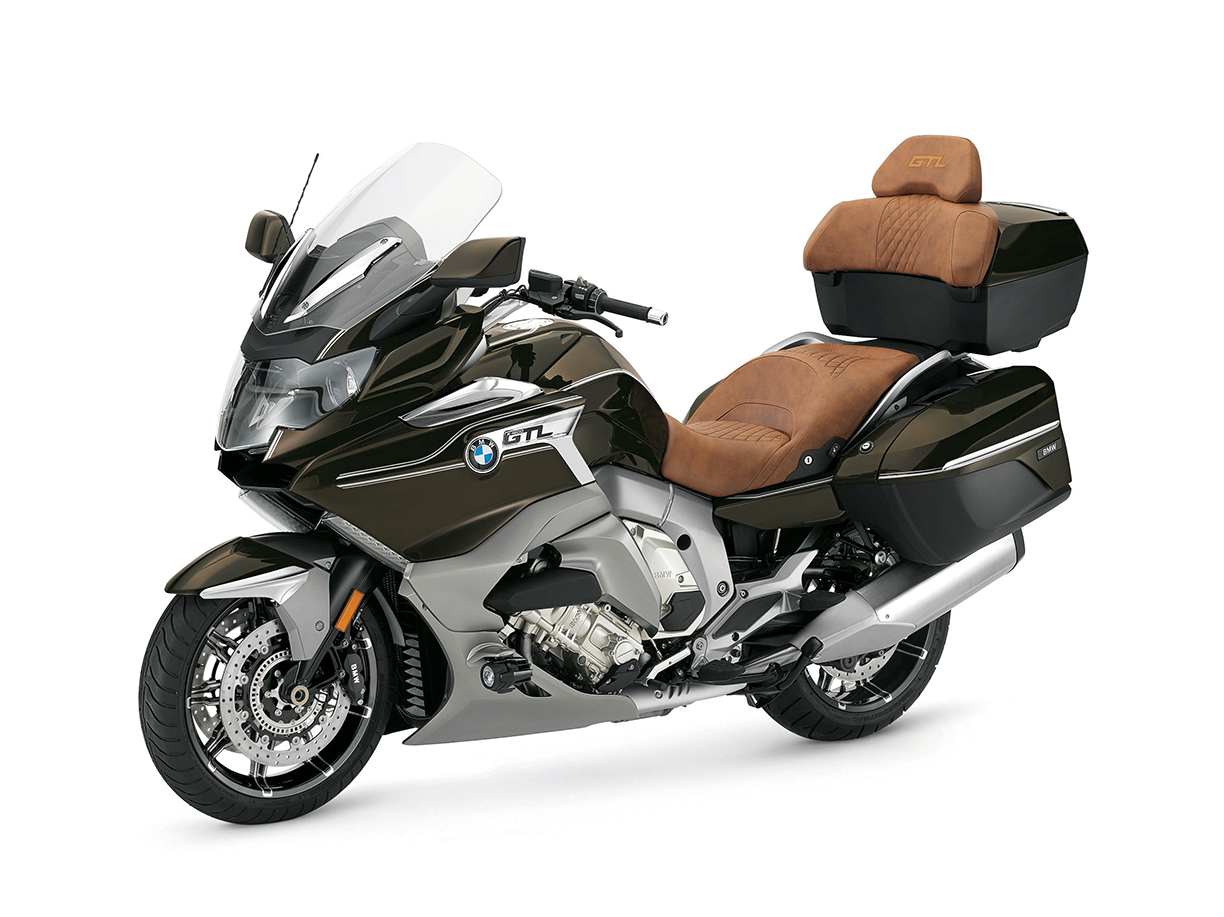
Photo courtesy of Arnold Debus.
BMW, K 1600 GTL
From $25,995
The K 1600 GTL by BMW is one of the fastest and most luxurious touring bicycles on the road. Prioritizing comfort, the motorcycle features a significant amount of space to easily conquer a long journey with a partner along for the ride. With cutting-edge sport touring technology, a six-cylinder in-line engine, and a multi-controller concept that allows you to switch functions without ever taking your hands off the handlebars, this bike was made to go the distance — in any weather condition. The K 1600 GTL is for the traveler who desires a reliable bike for a relaxing and equally high-end experience. Sit back and enjoy the ride.

Photo courtesy of Ducati Motor Holdings S.P.A.
Ducati, Panigale V4
Starting at $21,295
The Panigale V4 by Italian company Ducati is one of the fastest road-legal racing bikes to hit the market. The aggressive frame allows riders to throttle through curves and launch on straights; sophisticated electronic controls unlock the reigns beyond standard limitations. The bike is a true celebration of Ducati’s long-lasting racing spirit. Designed to treat the freeway like the track, this efficiently aerodynamic bike is for the true daredevil motorcyclist.
Many contemporary luxury watches are inspired by the sleek aesthetics and seductive instrumentation of the automobile and aerospace industries, resulting in endorsement deals with Formula One drivers and marketing campaigns featuring test pilots. Some of the high-tech materials that make sports cars and fighter jets lightweight and aerodynamic are now incorporated into watches.
For many consumer products, there is a correlation between weight and value, a concept manufacturers have, sometimes misleadingly, reinforced. Watchmakers, whose sleek, svelte products have evolved into large, chunky ornaments per current style, have been forced to explore the use of lighter materials. Now the ethereal is being equated with value, and the race to lightness has produced some remarkable products.

Astronaut photo courtesy of NASA; Watch photo courtesy of Roger Dubuis.
Several lightweight watches later, Richard Mille introduced the RM 50-03 McClaren F1 model in 2017, a limited edition of 75 pieces priced at $980,000. At less than 40 grams (including the strap), it became the world’s lightest split-seconds chronograph tourbillon watch. That product introduced a new nanomaterial called graphene (aka Graph TPT) that is 200 times stronger than steel but far lighter. Noting watchmakers’ proclivity to mimic machines on the race track, Adams suggests, “Timepieces are often referred to by modern watchmakers, including Richard Mille, as ‘race cars for the wrist.’”
Lightweight materials like carbon fiber and titanium have been adopted by manufacturers of mass-produced watches, brands such as Citizen and Casio, but luxury watchmakers are consistently pioneering newer, lighter materials. The carbon nano-fibers employed by Richard Mille are similar to what are used for the U.S. Air Force’s stealth bombers, and graphene is being tested by McClaren for its Grand Prix race cars. “I’ve worn many lightweight Richard Mille watches and they’re very cool,” reports Adams. “The irony is that the more lightweight they are, the more difficult it can be to present them as the mega-luxury products their prices suggest,” he adds.
Ariel Adams, whose A Blog to Watch is a leading resource for watch enthusiasts, reports, “Watch brands typically are poor at selling anything new, and thus rely on other products and industries who have already created an appetite for particular materials or themes.” He cites comfort as a prime motivation for reducing weight, stating, “There’s a very real reason why a collector might prefer to wear a watch that’s barely noticeable as opposed to a ‘gold brick on the wrist.’”
Nancy Olson, managing editor at Inter-national Watch (iW) magazine, reports, “It’s all about expanding the limits of development and design to set themselves apart within a somewhat crowded watch market, as well as, in this instance, sturdiness and comfort—particularly in the sport watch arena.” Richard Mille, arguably the trendiest brand in watches, is particularly influential in sport-themed design.
At the French Open in 2010 Richard Mille debuted the RM 027 tourbillon watch, a limited edition designed for tennis superstar and brand ambassador Rafael Nadal. Able to withstand the violent gravitational forces he produces on the clay court, the watch weighs a mere 19 grams (0.670 ounces) with its strap, thanks to a carbon-based composite. The entire movement, crafted from titanium and a high-lithium content alloy — the light yet durable lithium is used in aircraft, rockets and race cars — weighs just 3.83 grams (0.135 ounces).
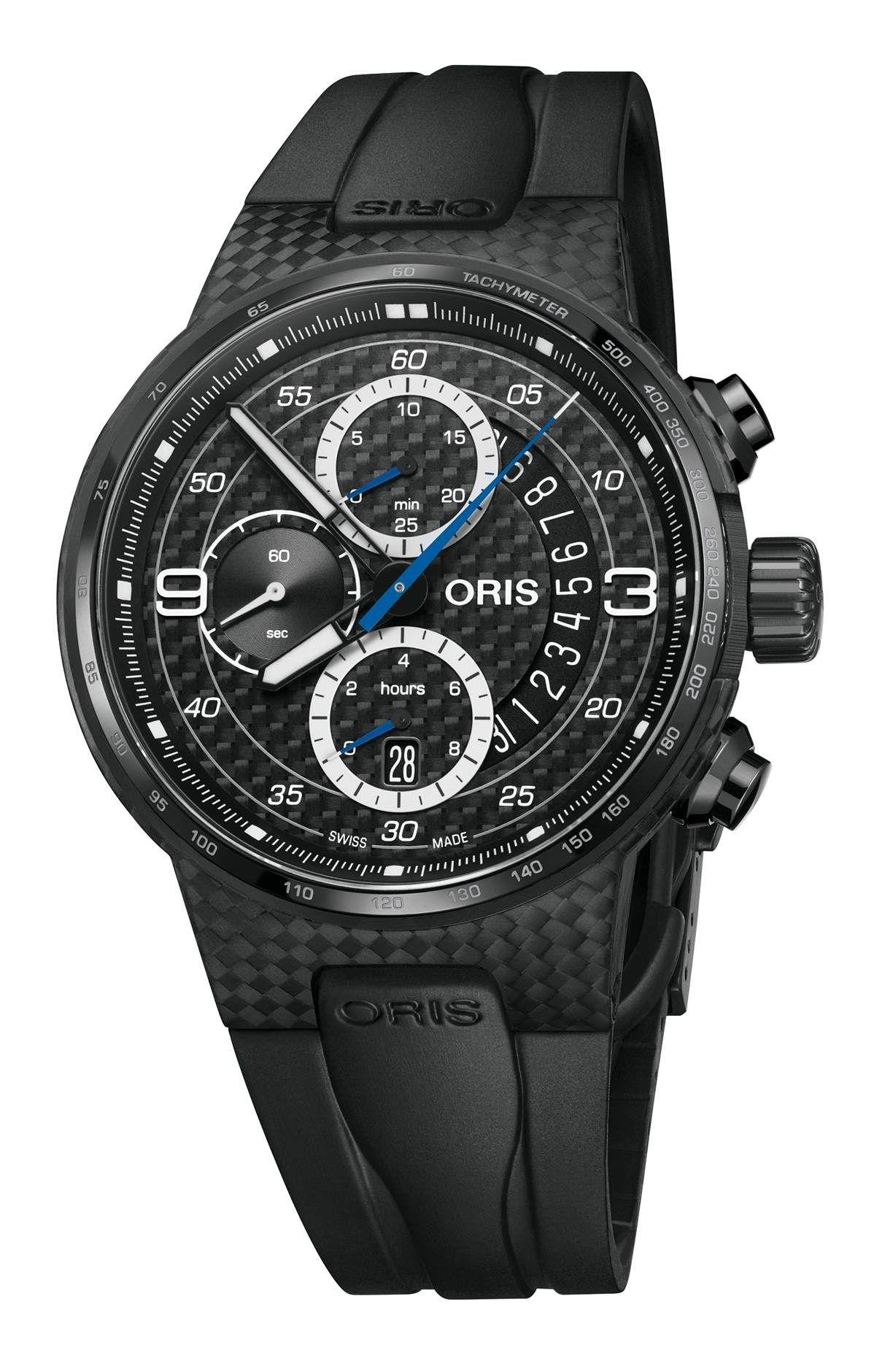
Oris Williams FW41: Limited Edition. Photo courtesy of Oris.
Richard Mille is not the only manufacturer with a connection to auto racing, and the FW41 from Oris is part of a racing-themed collection that celebrated the Williams Team’s 41st season on the Formula One circuit. The total weight of this limited edition watch, comprised largely of carbon fiber and titanium, is not disclosed but the middle case weighs in at only 7.2 grams (0.254 ounces).
Known for capitalizing on trends set by more expensive watchmakers, Oris brings greater accessibility to feather-weight watches, as the FW41 costs approximately $4,350. With its patterned black carbon fiber dial, the FW41 has a dark, sultry aesthetic, reminiscent of the aircraft that share the same materials. Roger Dubuis, which frequently collaborates with iconic racing brands Lamborghini and Pirelli, uses carbon and titanium to lighten its skeleton-style Excalibur Spider watches, both an automatic model and flying tourbillon.
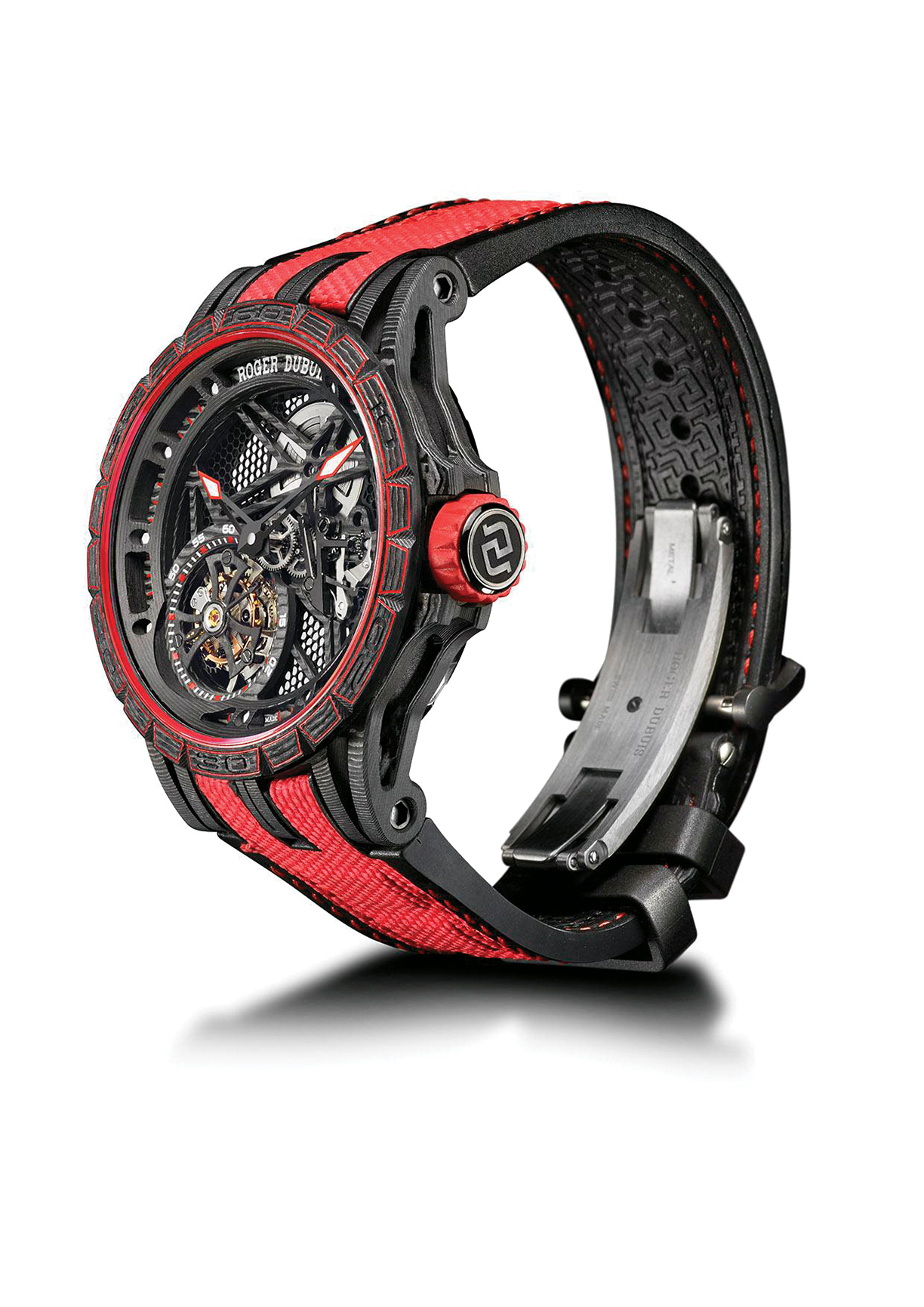
Excalibur Spider Carbon Skeleton: Flying Tourbillon RD509SQ. Photo courtesy of Roger Dubuis.
Montblanc, the legendary German manufacturer of writing instruments, is also a superb watchmaker and in 2016 it released a concept watch, the Time-Walker Pythagore Ultra-Light that weighed in at an extraordinary 14.88 grams (0.525 ounces) sans the strap. Montblanc achieved this lightness through skeletonization and the use of mineral glass, titanium and a Swiss composite material charged with car-bon nanotubes called Innovative Technical Revolutionary Resin.
For those who value a thin profile even more than lightness, the crown would go to Bulgari, which at Baselworld 2019 — the celebrated timepiece/jewelry exhibition held in Switzerland every spring — debuted the thinnest automatic wristwatch in the world. The venerable Italian brand has long specialized in ultra-thin watches and with a 3.3mm movement housed in a case just 6.9mm thick, Bulgari’s razor-thin Octo Finissimo Chronograph GMT is the company’s latest achievement in condensing complex mechanisms.
Ariel Adams cautions that thin watch engineering differs from lightweight watch engineering in significant ways. “Thin watches tend to be a lot more diffcult to make because you aren’t just working with materials but also tolerances and moving parts that need to go next to one another,” he explains. While the Octo Finis simo secures a new title for Bulgari, Piaget (another specialist in slender timepieces) holds the record for mechanical watches. “While thin watches can also be lightweight, appreciating the effort that’s required to make them is an entirely different discussion,” insists Adams.
Nancy Olson, who professionally observes the often-fickle trends in watch-making, does not dismiss the flight-to-light or thin-is-in movements. “A trend always leaves something behind, even when the expression of it evolves,” she states, adding, “Every milestone in watchmaking changes the whole in some way.”
Light & Lean
Bulgari- www.bulgari.com
Montblanc- www.montblanc.com
Oris- www.oris.ch
Piaget- www.piaget.com
Richard Mille- www.richardmille.com
Roger Dubuis- www.rogerdubuis.com
Resources
A Blog to Watch- www.ablogtowatch.com
International Watch- iwmagazine.com

Richard Mille RM 027 Tourbillon – Rafael Nadal.
Photo courtesy of Richard Mille.

The Run To Ibiza
Roger Dubuis has created “The Run To…,” a series of extraordinary supercar adventures, with the signature drive concluding at the Monaco Grand Prix. Participants pass through unrivaled natural beauty in the world’s finest automobiles, enhanced with fine cuisine, lavish accommodations and world-class entertainment. The glamour of these journeys fuel the company’s inspired watchmaking. Photo courtesy of The Good Life Inc.
Surfing has always been one of the most approachable, laid-back sports in the world, with no cost to entry beyond access to a public beach, a second-hand board and a pocketful of change for an after-wipeout fish taco. But with iconic luxury brands like Louis Vuitton and Hermès creating boards for their exclusive clienteles, another side to the sport has emerged.
Among the most striking boards available are those from Haleiwa Surfboard Company, at which septuagenarian surfer and veteran artisan Mahlon (“Lon”) Klein typically crafts no more than 15 exquisite wooden boards per year. Located on Oahu’s North Shore, one of Hawaii’s most storied surfing destinations, Haleiwa incorporates indigenous hardwoods such as koa, mango, kamani, and monkey-pod into its unique boards.
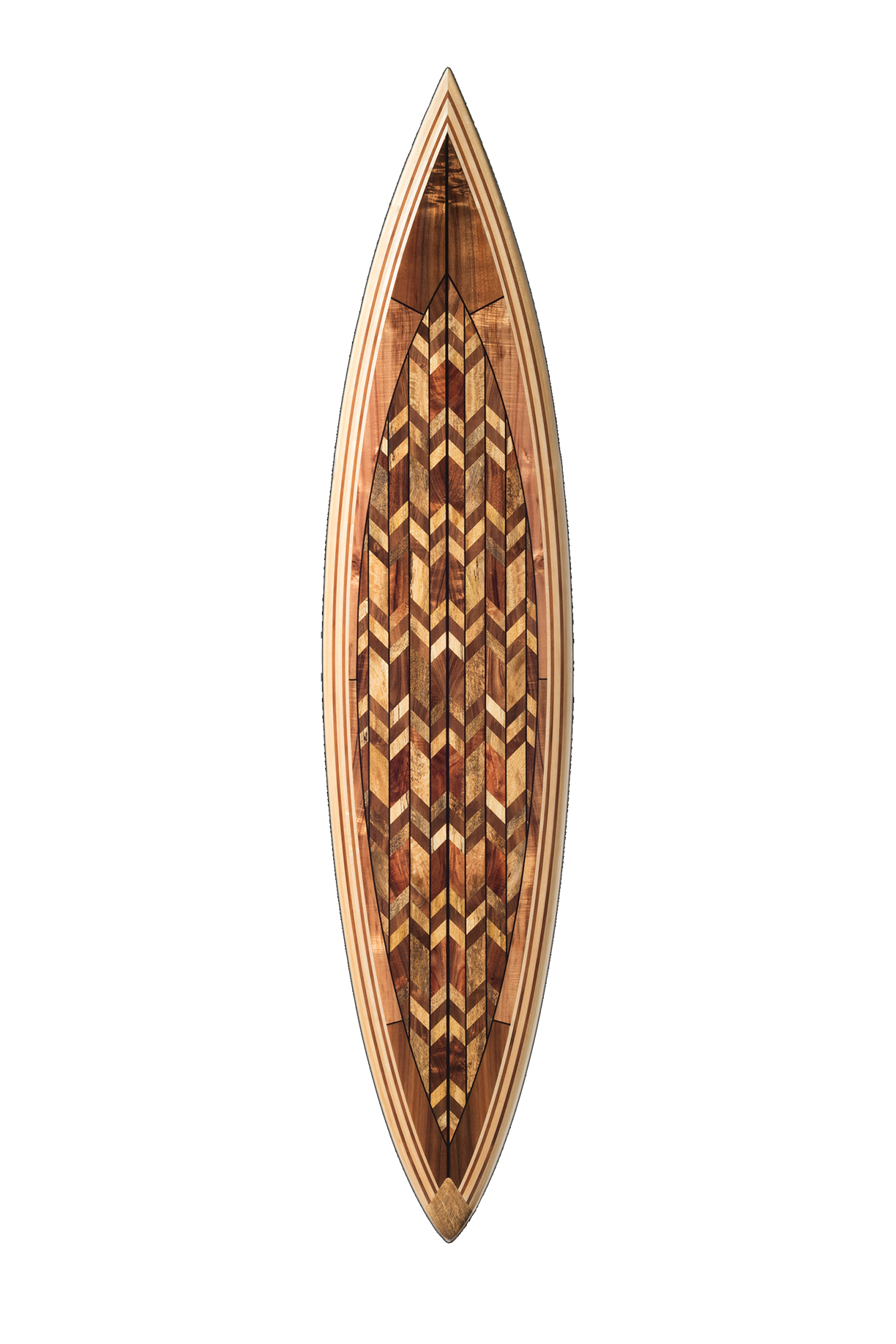
#68: Hand-crafted by: Lon Klein @ Haleiwa
Dimensions: 7′-3″ X 18 1/2″ X 2 5/8″
Surfboard Company Deck: Koa, mango
Shape Design: Dick Brewer Bottom: African mahogany
Photo courtesy of John Bilderback.
Klein originally began crafting boards from lightweight woods, and some are used to this day by pro surfers Michael Ho and Roger Erickson, but he eventually sought out more attractive woods that are too heavy for competitive surfing. “My audience was no longer the surfing market but the art market,” explains Klein, who insists no two of his boards are alike. “I never thought of myself as an artist,” says the native Californian who moved to Hawaii for the surfing. “But I’m always trying to accentuate the beauty of the shape itself,” he adds.
Klein says that more than 200 hours of labor go into each handcrafted, triple-gloss-finished board, and the artisan has no interest in compromising his craft for mass-production. Haleiwa Surfboard Company’s worldwide following includes clients from Europe to Japan, and Klein reports that a member of the Moroccan royal family purchased a pair of the wood-clad “sticks.” The firm’s larger surf-boards are currently priced at $22,000 while a shorter ver-sion commands $14,000.
Far from the iconic beaches of Hawaii or California is England’s LUX Surfboards, a collaboration of Ellie Miller, the only female professional board maker in Europe, and artist Danni Bradford. “The Aureus,” is their ’70s-inspired board, entirely sheathed in 24-karat gold leaf and currently priced at the equivalent of $45,600. The deck features a triple elliptical pinline design and the hull includes a single gilded fiberglass fin.
“A 24-karat gold surfboard had never been made before, and we were inspired by how unique it would be if we could achieve it,” says Bradford, whose studio is close to her favorite surfi ng spot in North Devon. “I’ve been riding Ellie’s surfboards exclusively for the last six years, and watching her grow as maker,” says Bradford, who adds, “It seemed only natural for us to combine our skills.”
“The board took months to complete, and it was incredibly painstaking,” says Bradford, who explains the gold was integrated into the construction of the board, not simply applied to the surface. The artist, acclaimed for her imaginative work with glass, says of her partnership with Miller, “I definitely think we’ll collaborate again on another board.”
In Los Angeles, designer Elisabeth Weinstock covers everything from handbags to soccer balls in exotic anaconda or boa skins. Her surfboards ($5,600), clad in snakeskin or other exotic leathers, are popular even with people who never venture into the waves. “Whether you’re a surf enthusiast or just appreciate the California beach vibe, this is the ultimate luxury objet d’art,” says Weinstock, who notes, “It was designed for the lover of the art of the sport.”
Kelly Wearstler, a prominent L.A. interior designer known for her trendy Holly-wood Regency- or Art Deco-in-spired hotel commissions, has also waded into surfboard design. Handcrafted from shaved Russian birch and sealed with surf resin, her $8,900 boards display compel-ling patterns, some organic and others more structured, that bring artistic expression to the sport. While you could conceivably paddle out on one of these glossy boards, they are primarily decorative, designed to bring the spirit of surfing indoors. Wearstler reports they were inspired by her love of the Malibu beach culture.
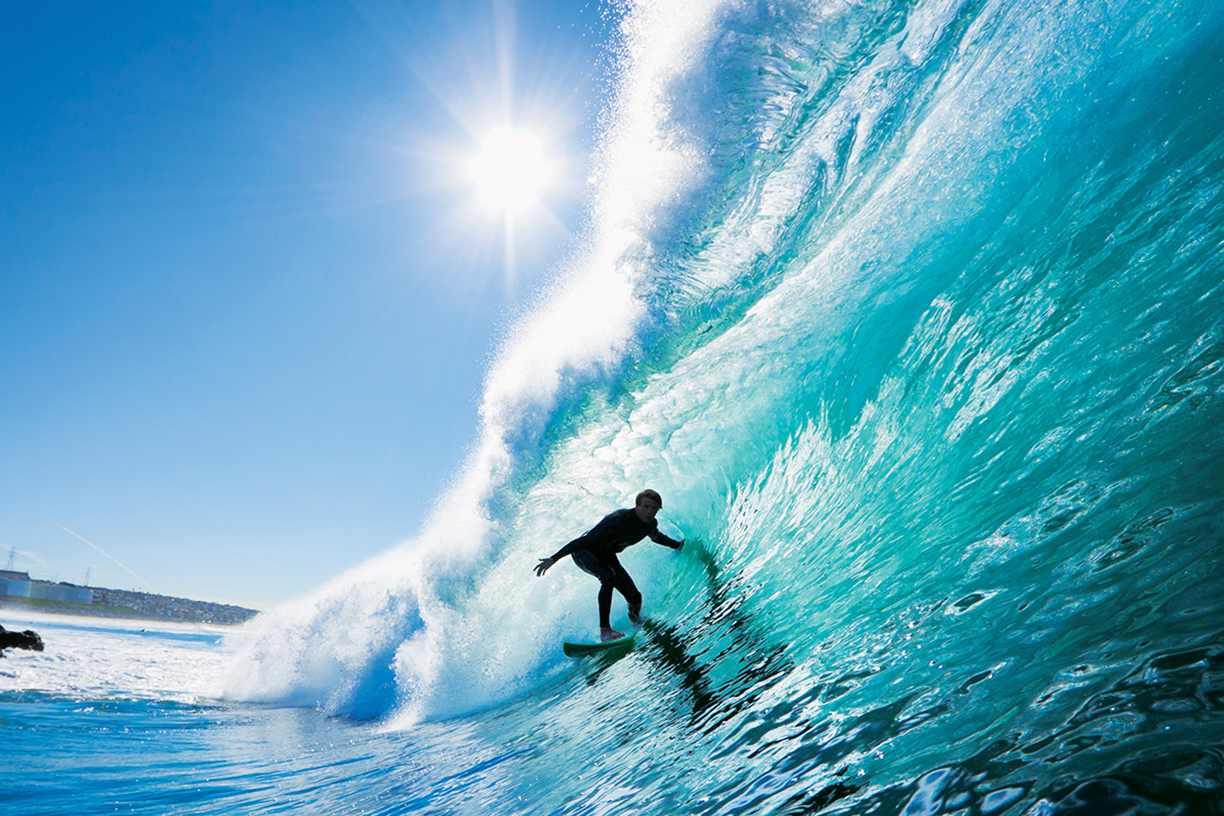
Photo courtesy of iStockPhoto.com/EpicStockMedia.
Hawaiian artist Tim Nguyen, whose idyllic images of his fellow Islanders are expressed with rich tropical colors reminiscent of Impressionist painter Paul Gauguin, presents his love of the Aloha State on a surfboard. His “Under Banana Leaves,” currently offered at specialty retailer Martin & MacArthur for $8,190, is the ideal piece of décor for a luxury Hawaiian estate — or even a Chicago penthouse whose owner yearns for the Maui sun.
“Art on surfboards is my expression of Island beauty, my passion for the ocean and the depiction of Hawaiian culture,” says Nguyen, who resides on the tranquil, unspoiled west side of Oahu where local traditions endure. “My board represents a scene in my imagination about a lush tropical garden,” reports the artist, whose frequent images of banana trees capture the magical qualities of Polynesian culture.
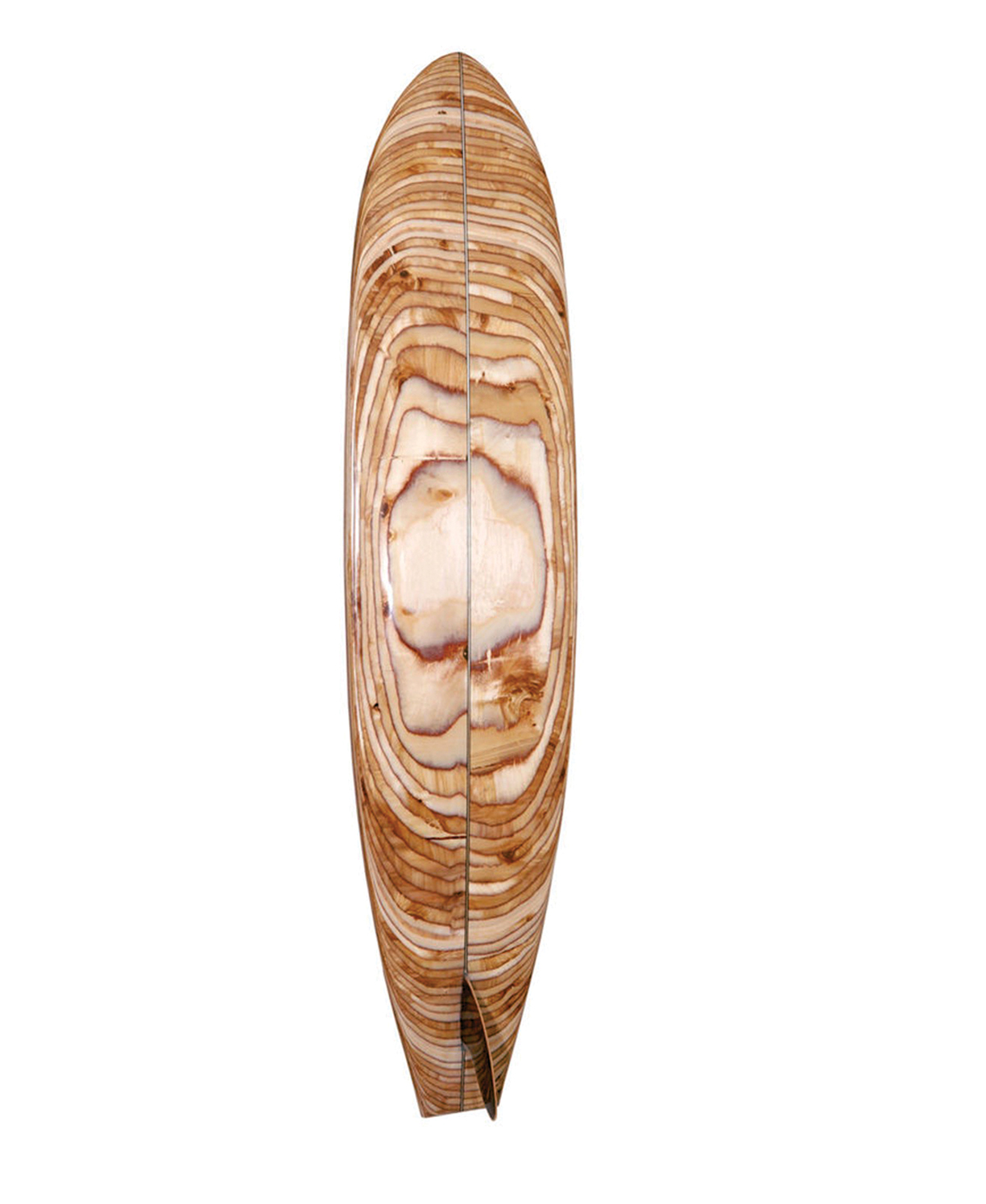
Russian Birch Board by Kelly Wearstler. Photo courtesy of Kelly Wearstler.
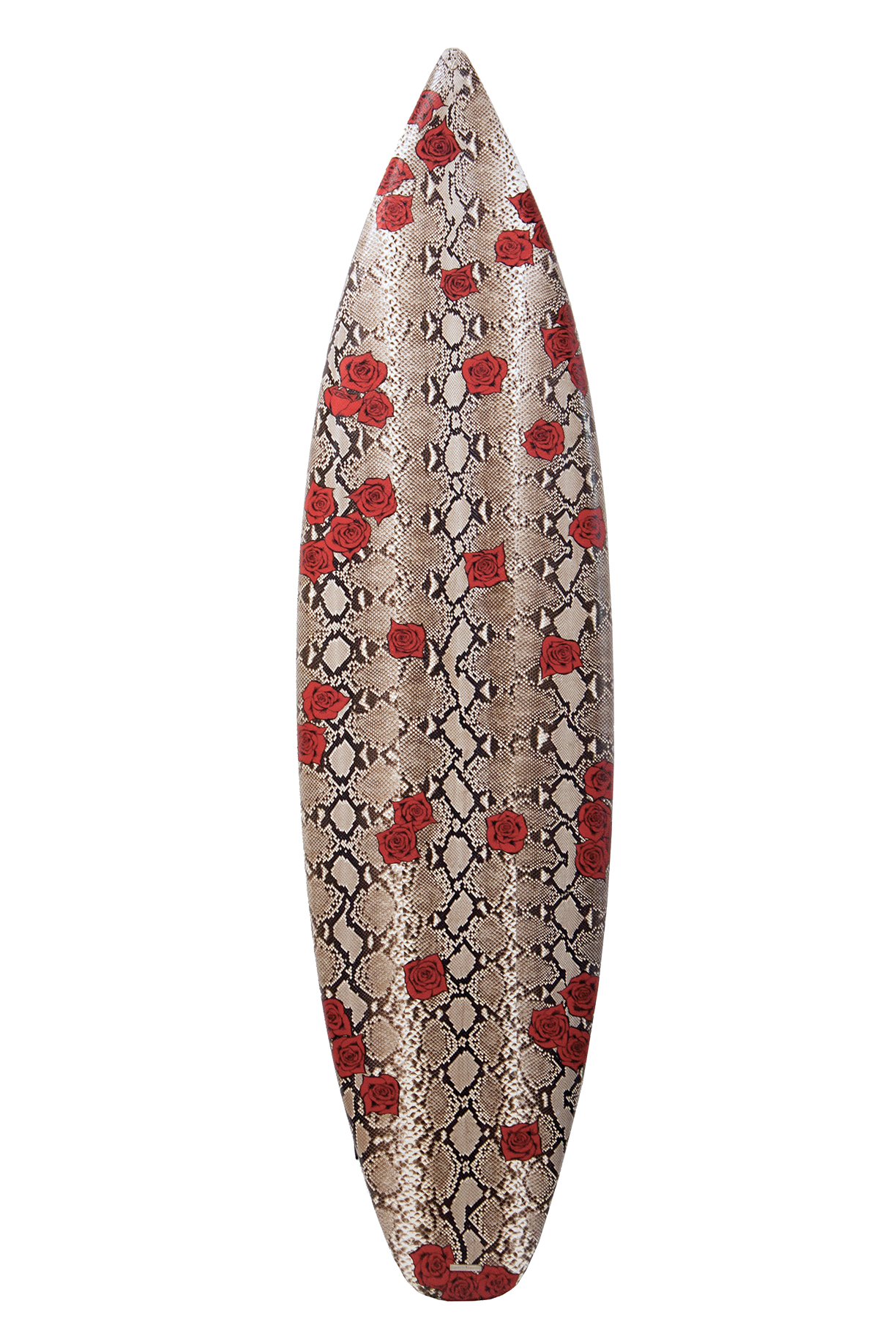
Roses surboard from Elizabeth Weinstock. Photo courtesty of John Milios.
The most expensive surf-board on record was created by New Zealand designer Roy Stuart in 2014 and priced at $1.3 million. The board, named “Rampant” was crafted from paulownia, an Asian tree known for lavender-colored blossoms and has a 23-karat gold lion emblem engraved into it. The hull of the board has a unique tunnel-shaped fin created from kahikatea wood, a towering tree native to New Zealand, along with a distinctive neon blue polycarbonate fin for further balance.
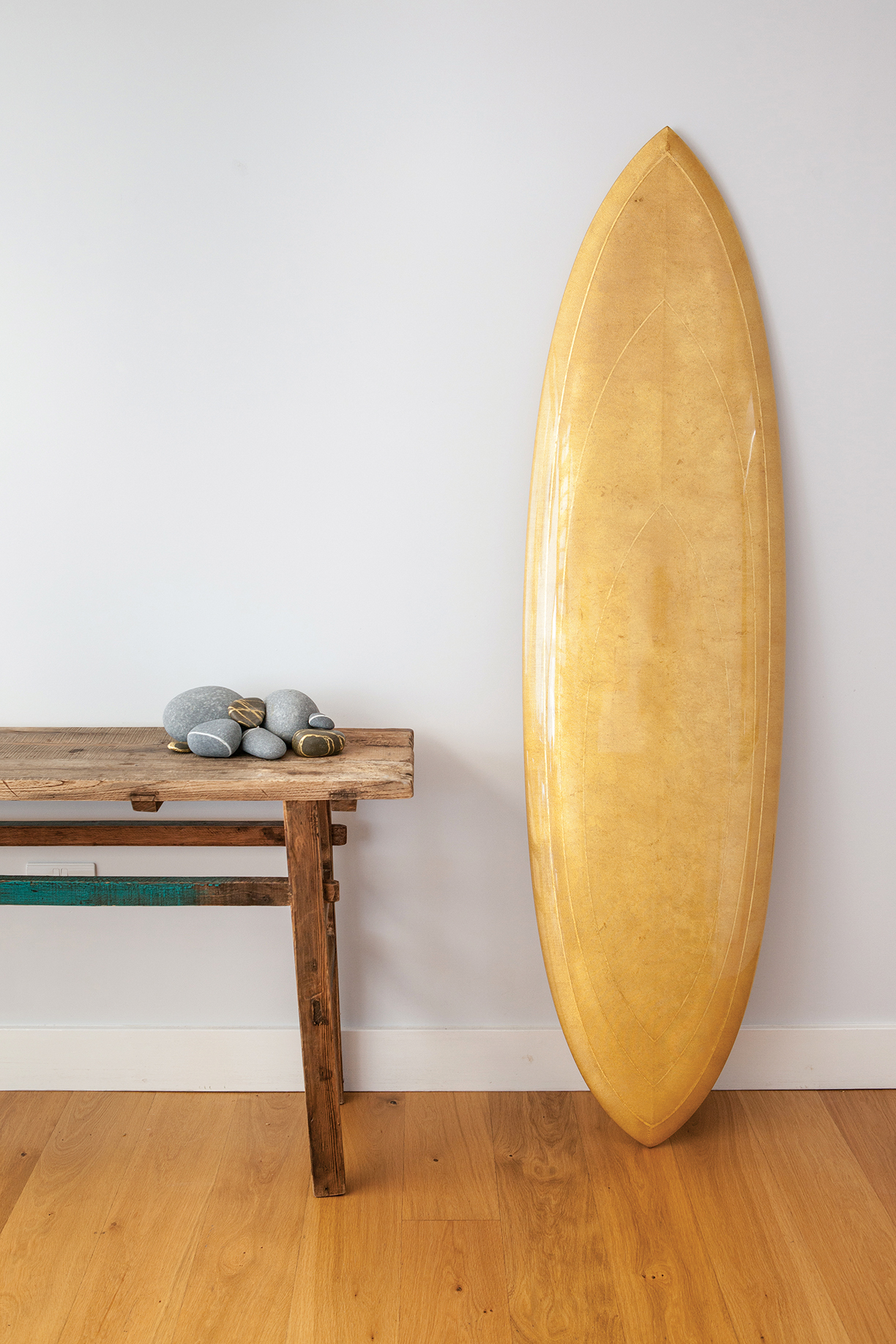
The Aureus by LUX Surfboards. Photo courtesy of M. Corker / Shimnix Films.
In addition to iconic fashion labels delving into surf culture — Chanel currently offers an elegant board for $8,900 — auto manufacturers like Peugeot and Tesla have also applied their distinctive style and engineering to the once-pedestrian boards. Mercedes-Benz created the “Silver Arrow of the Seas,” an aerodynamic carbon-fiber board with the sleek good looks of a sports car, tailor-made for monster wave master Garrett McNamara. In 2014, the legendary surfer used the board to ride some of the most enormous waves on record off the coast of Nazaré, Portugal.
Sophisticated Sticks
Elisabeth Weinstock
www.elisabethweinstock.com
Haleiwa Surfboard Company
www.haleiwasurfboards.com
Kelly Wearstler
www.kellywearstler.com
LUX Surfboards
www.luxsurfboards.com
Martin & MacArthur
www.martinandmacarthur.com
Homes grouped around a small collection of shops, churches, banks, a doctor’s office and a barber. It’s the way cities and towns developed. Today, a similar process is underway in Vancouver, Miami, Baltimore, San Jose, Memphis and many other cities, except expansion is as much upward as it is outward in a new vision of community considered a “vertical village.”
The concept found early proponents in Asia, where space is at a greater premium. Now, similar neighborhoods are taking shape in the U.S. and Canada, often in former industrial or commercial sites. In Memphis, Cross-town Concourse is rising in a former Sears distribution center and retail outlet the size of 25 football fields. In Atlanta, another abandoned distribution center is the foundation for Ponce Market, a mixed-use community adjacent to the Beltline. And in an era when retail seems to be threatened, shopping malls — not the familiar single-dimension covered expanse, but open sites inviting participation — are the foundation for vertical villages along with a mix of residences in multiple buildings and varied price brackets.
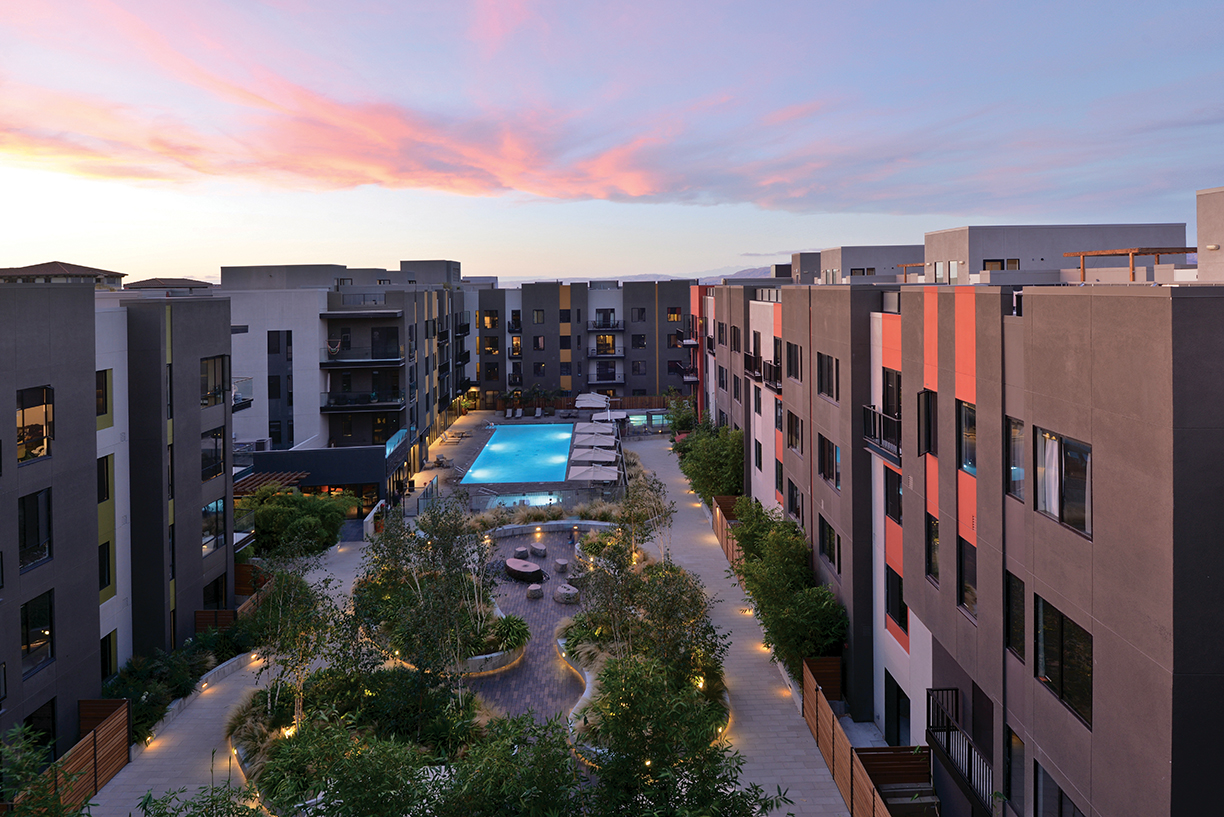
Misora Santana Row. Photo courtesy of Ankrom Moisan Architecture.
However, no matter how well meshed, retail and residential alone do not create community. Instead, the addition of parks, trails, green spaces, grocery stores, farmer’s markets, performance centers, galleries, venues for the arts, wellness, education and medical and dental facilities turn what might be simply a new mall into a community.
Arts and culture are a focus at Crosstown Concourse, which is a collaborative effort, focused on the arts. Here, residents are perceived as embodying the spirit of the place.
Santana Row in West San Jose, California, is another relatively new mixed-use community incorporating retail, offices and residential.
“Community is engrained in everything we do here at Santana Row,” says Collette Navarrette, West Coast marketing director for the developer, Federal Realty Investment Trust. “The center-wide amenities, highly engaged residents, and unique community events that Santana Row offers inspire and connect people in a meaningful and lasting way.
The concept of a vertical village might be mainstream for developers, but it’s still new to consumers. One of their biggest questions is whether the convenience and community will meet their needs and most especially their values, according to data scientist David Allison, who heads an eponymous global advisory firm. He says it all comes down to values. “What we value determines what we do.”
Allison brings new insights into con-sumer behavior. He contends traditional demographic parameters of age and gender do not work in today’s market. “People really don’t act their age anymore. Gender rules and norms are less important than ever before. In fact,” he says, “we live in a post-demographic era. Allison’s firm has amassed data from almost half a million people regarding 40 core human values as well as several hundred other needs, wants and expectations. Their database, Valuegraphics, shows that people in the traditional demographic categories have little agreement — only 13 percent of the time for Boomers, 11 percent for Gen X and 15 percent for Millennials. Humans overall only agree 8 percent of the time. Instead, Valuegraphics data uncovered 10 huge groups or architypes who agree on pretty much everything.
To profile those drawn to a vertical village, Allison combined this data with additional research among 1,864 North Americans who indicated interest in such a community. The results reveal several major interest profiles.
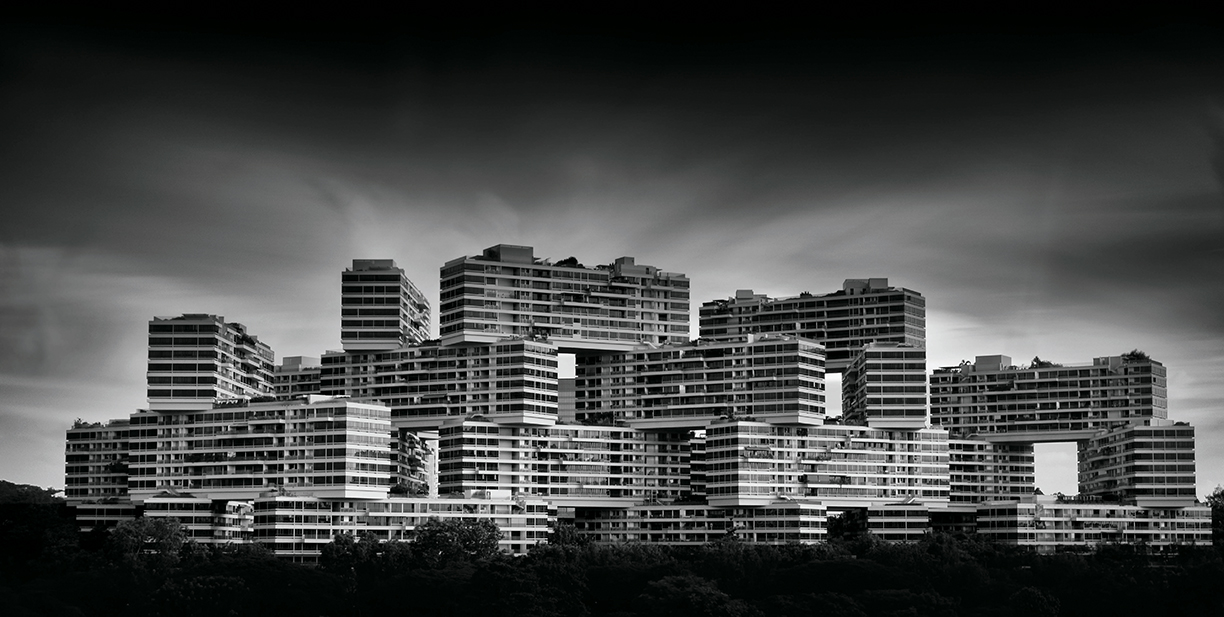
The Interlace in Singapore, designed by Ole Scheeren and Oma, established a new vision for urban residential living. Photo courtesy of Mike Cartmell.
Local Experience
Chasers Approximately 32 percent literally pursue experience after experience, but they like to have those experiences close to home. “They want to do things they love again and again,” says Allison. Loyal to things that trigger a sense of belonging, they are apt to join a team or club and love to see the same faces. Quality of life often means quality of social life. A sense of belonging is important and they like the idea of multipurpose living. Allison says for this group extra thought should be given to programming. A 3D walkthrough of a yet to be finished building would have great appeal.
Workaholic Investors
Comprising 19 percent of potential residents, this group values financial security, material possessions and wealth. They are likely see a place in a vertical village as an investment. Allison says, “They are thinking long term about all of the component parts of the offering.” They are likely to be attracted to the proximity of amenities. Who lives in the building could also be an incentive for them.
Creative Savers
This group, which comprises about 16 percent of the sample, gravitates to places that will foster their own creativity. They accept potential financial challenges presented by a creativity-centered life. They are likely to have children and are attracted to inspiring design, cozy common areas and quaint trails meandering through parks, according to Allison.
City Loving Environmentalists
The last of the major archetypes, this group sees this style of community as being better for the environment and is motivated to reduce their carbon footprint. They love city living but appreciate and value of parks and green spaces. Highly educated and loyal, they are attracted to diversity. Family and relationships as well as health and wellbeing are also important to them.
Another group, about 18 percent of the sample, is composed of varied smaller architypes, which indicate going vertical might represent a substantial cross section of consumers.
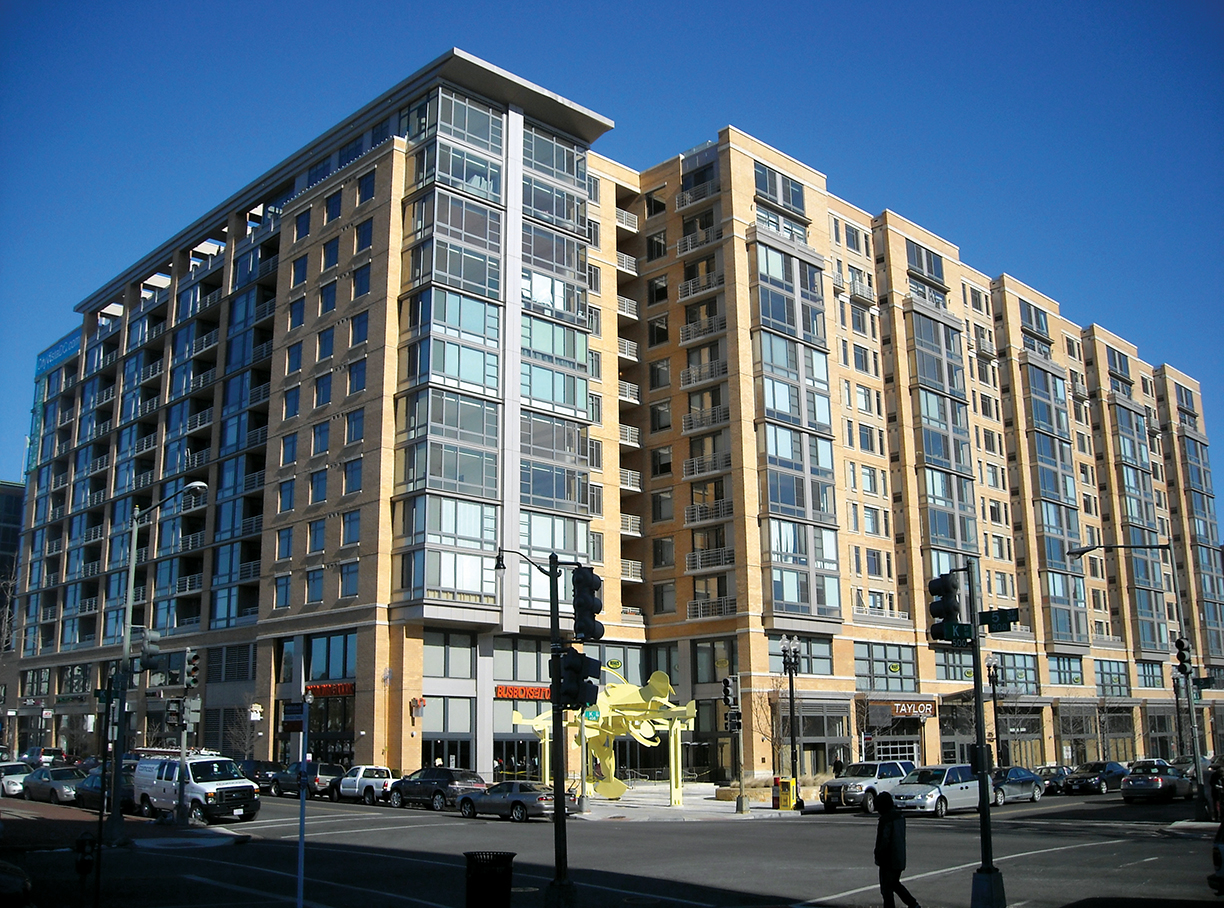
CityVista, a mixed-use development, located at 475 K Street, N.W., in the Mount Vernon Square neighborhood of Washington D.C. Photo courtesy of Creative Commons by AgnosticPreachersKid.


